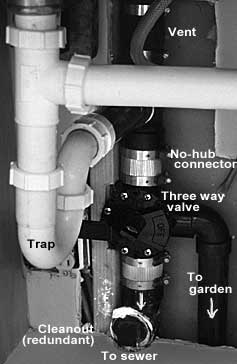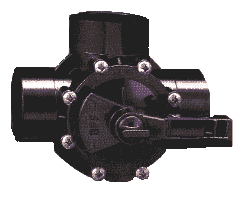Three Way Diverter Valves, aka Three Port Valves, 3-Way Valves, L-Port Valves for Greywater Systems

Three way diverter valves are recommended for greywater systems:
- To divert water between landscape and septic system/ sewer, if you want to launder with bleach, irrigation is not needed, or it's frozen out there...
- To switch greywater between alternate irrigation zones in the garden
Diverter valves are required by most greywater codes. (Some codes allow systems without diverter valves if the receiving landscape has enough capacity to accept greywater in all instances.)
Three way valves work better than the alternatives (two ball valves, movable pipe sections...) in that they are more likely to be used properly and that they don't clog as readily.
1"Threaded 3Way L-Port Brass Ball Valve for Washing Machines
This high quality brass three port valve is recommended for laundry-only systems, in particular, the Laundry to landscape system. It has one-inch female pipe thread. Note: unlike the valve below, the inlet can only be the leg of the tee (the part pointing down in the image at right), with the water diverting to the either side of the run.
![]() $59 — Three-Way Laundry Diverter Valve 1" (brass)
$59 — Three-Way Laundry Diverter Valve 1" (brass)
 |
| Three way valve installed |
1.5" or 2" Three Port Diverter Valve are needed for House Plumbing—
WE NO LONGER OFFER THESE due to supply chain issues.
 These three port valves are the greywater industry
standard. Besides being well-made, lifetime-lubricated, and guaranteed never to leak or break,
they have the huge advantage that you can unscrew the face plate and turn
it to make any of the three ports the "inlet."
These three port valves are the greywater industry
standard. Besides being well-made, lifetime-lubricated, and guaranteed never to leak or break,
they have the huge advantage that you can unscrew the face plate and turn
it to make any of the three ports the "inlet."
The face plate can also be removed for cleaning out the valve or nearby clog.
They last a long time. We suggest you use "no-hub connectors" if there is space, or glue them with silicone sealer if there is not, so they can be reused if you want to change the geometry of your plumbing in the future.
The valves can be operated remotely and/or automatically with a motor actuator (we don't handle these; they are quite expensive).
The valve fits two pipe sizes; one on the inside (1.5") and one on the outside (2") of the hubs.
Why these valves are superior to ball valves in a greywater application
We had a customer write to us,
Customer: "What I don’t like about the valve is the large cavity and jagged edges within which will be a potential for debris to build up and cause clogs. I think I am better off with a simple 2" ball valve (yes more work to splice two valves in) which present a smooth diameter wall to the flow. I am a mechanical engineer, I know a thing or two about flow. I am afraid to take a chance with your valve."
Oasis: "All of us thought that about those valves. However, empirical data trumps theory, and in this case none of us have ever seen a clog at these valves in twenty years of field experience. This came up for the city of Tucson, and I just checked a month ago with the guy who has put in more of these for greywater than any of us in the country, and he's never seen a clog at these valves, either. Makes no sense to me, but there's 20 years of in the field experience that contradicts what I, and everyone thinks would happen. (Moreover, if it does clog, you can unscrew the face of and clear it.)
Experience has not been so kind to dual ball valve installations. The dead end run tends to clog with a plug of crud which won't easily dislodge when the valve is moved. This is an experiment that has been replicated many times. If one chooses to go this route, I suggest making it dissasembleable and writing up your results after a few years of use (it takes a while for the crud plugs to form--most diverter valves are left in the same position for weeks or months at a time). I don't think anyone has ever quantified this. There is a pool valve called an Ortega valve which is the best of both worlds, (a smooth diverter valve) but it only works in one geometry and I don't think I've ever seen them in a greywater system, only on the shelf.
It's kind of unnerving to not have a single failure; this is like the only part of greywater systems that doesn't clog. It makes me wonder if the turbulence might actually be helping to mobilize stuff, or some other apparently 2nd order effect that's actually dominating."
With "radical plumbing," you don't need diverter valves
Also, consider that the whole idea of diverting greywater "elsewhere" is suspect. If it is too toxic to put on your garden, where exactly is it OK to put it? A more fundamental solution is to not buy anything that can't go on the garden, then put it all on the garden full time; no diverter valves. Some codes allow greywater systems without diverter valves or the existence of septic or sewer, if the recieving landscape has enough capacity.
For a way to accomplish this and avoid 90% of the plastic and all the PVC use in a system, check out our information on Radical Plumbing in Oasis greywater-book, which also explains how to calculate recieving capacity.
See also:
- Stub outs how to plumb for a future greywater system
- Flow splitters (hardware) Hardware for splitting greywater flows in a branched drain greywater system
- Oasis greywater-book chapter on how to do greywater collection plumbing
- Laundry to landscape greywater system for washing machine only
- Laundry 2 landscape-video Instructs how to build our simplest, most economical system from start to finish
- Greywater central Information on all aspects of greywater systems
